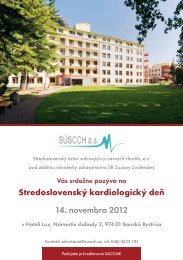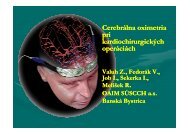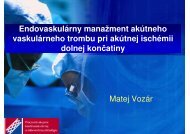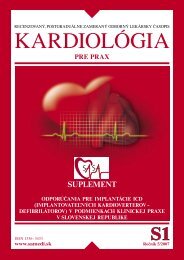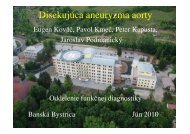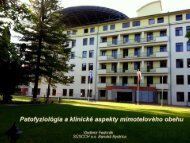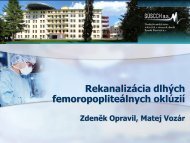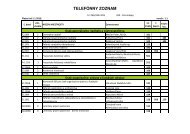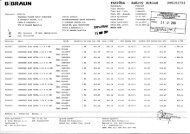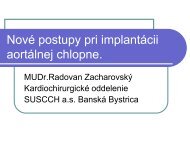Management of acute myocardial infarction in patients presenting ...
Management of acute myocardial infarction in patients presenting ...
Management of acute myocardial infarction in patients presenting ...
You also want an ePaper? Increase the reach of your titles
YUMPU automatically turns print PDFs into web optimized ePapers that Google loves.
ESC Guidel<strong>in</strong>es 2931<br />
Table 20 Imag<strong>in</strong>g modalities: tim<strong>in</strong>g and usefulness<br />
At presentation With<strong>in</strong> 48 h Before or after discharge<br />
.............................................................................................................................................................................<br />
Echo at rest<br />
If required for For LV function and presence <strong>of</strong> For LV function, heart failure, shock, or new<br />
diagnosis<br />
thrombus<br />
murmur<br />
Stress ECG<br />
For ischaemia<br />
Stress perfusion SPECT<br />
For viability and ischaemia, <strong>in</strong>farct size<br />
Stress echo<br />
For viability and ischaemia<br />
PET (rest)<br />
For viability<br />
MRI (rest, stress,<br />
contrast-enhanced)<br />
For LV function, <strong>in</strong>farct size, viability, and<br />
ischaemia<br />
Echo ¼ transthoracic echocardiography or transoesophageal if required; LV ¼ left ventricular; MRI ¼ magnetic resonance imag<strong>in</strong>g; PET ¼ positron emission tomography;<br />
SPECT ¼ s<strong>in</strong>gle-photon emission computed tomography.<br />
3. Evaluation <strong>of</strong> risk <strong>of</strong> arrhythmia<br />
for prevention <strong>of</strong> sudden death<br />
Primary prevention (prophylaxis) refers to treatment <strong>of</strong> subjects<br />
who are at at risk but have not yet had a life-threaten<strong>in</strong>g ventricular<br />
arrhythmia or SCD episode.<br />
Patients without symptomatic arrhythmias and those with EF<br />
40% are at such low risk <strong>of</strong> SCD that further test<strong>in</strong>g or prophylactic<br />
therapy is not <strong>in</strong>dicated.<br />
Factors that <strong>in</strong> addition to reduced EF have been demonstrated<br />
to contribute to the risk for SCD <strong>in</strong>clude the presence <strong>of</strong> nonsusta<strong>in</strong>ed<br />
VT, symptomatic heart failure, and susta<strong>in</strong>ed monomorphic<br />
VT <strong>in</strong>ducible by electrophysiological test<strong>in</strong>g. It is important to<br />
stress that the cl<strong>in</strong>ician’s ability to stratify <strong>patients</strong> us<strong>in</strong>g risk<br />
markers other than the ones mentioned is limited related to the<br />
lack <strong>of</strong> large prospective studies. Although T-wave alternans 182<br />
and other ECG techniques (heart rate variability/turbulence, QT<br />
dispersion, baroreflex sensitivity, and signal-averaged ECG) may<br />
be useful, additional studies are needed to further clarify their<br />
role <strong>in</strong> assess<strong>in</strong>g the risk <strong>of</strong> SCD <strong>in</strong> differ<strong>in</strong>g cl<strong>in</strong>ical sett<strong>in</strong>gs.<br />
G. Rehabilitation and<br />
pre-discharge advice<br />
Rehabilitation is aimed at restor<strong>in</strong>g the patient to as full a life as<br />
possible, <strong>in</strong>clud<strong>in</strong>g return to work. It must take <strong>in</strong>to account physical,<br />
psychological, and socio-economic factors. Rehabilitation<br />
should be <strong>of</strong>fered to all <strong>patients</strong> after STEMI. The process should<br />
start as soon as possible after hospital admission, and be cont<strong>in</strong>ued<br />
<strong>in</strong> the succeed<strong>in</strong>g weeks and months. Rehabilitation programmes<br />
should be multidiscipl<strong>in</strong>ary and aimed at reduc<strong>in</strong>g risk factors for<br />
coronary artery disease (see also Section H 183 ). Home- and<br />
hospital-based rehabilitation seem to be similarly beneficial. 184<br />
The details <strong>of</strong> the rehabilitation programmes are dealt with <strong>in</strong><br />
the position paper <strong>of</strong> the Work<strong>in</strong>g Group on cardiac rehabilitation<br />
and exercise physiology <strong>of</strong> the ESC. 185<br />
1. Psychological and socio-economic<br />
aspects<br />
Anxiety is almost <strong>in</strong>evitable, <strong>in</strong> both <strong>patients</strong> and their associates,<br />
so that reassurance and explanation <strong>of</strong> the nature <strong>of</strong> the illness<br />
is <strong>of</strong> great importance and must be handled sensitively. It is also<br />
necessary to warn <strong>of</strong> the frequent occurrence <strong>of</strong> depression and<br />
irritability that more frequently occurs after return home. It must<br />
also be recognized that denial is common; while this may have a<br />
protective effect <strong>in</strong> the <strong>acute</strong> stage, it may make subsequent acceptance<br />
<strong>of</strong> the diagnosis more difficult. Large studies suggest a role<br />
for psychosocial factors as prognostic factors <strong>in</strong> cardiovascular<br />
disease, 186 with the strongest evidence for depression as a negative<br />
factor <strong>in</strong> post-<strong><strong>in</strong>farction</strong> <strong>patients</strong>. However, whether depression is<br />
an <strong>in</strong>dependent risk (after adjustment for conventional risk factors)<br />
is still unclear and there is, so far, little evidence that any <strong>in</strong>tervention<br />
target<strong>in</strong>g these factors improves prognosis. 187,188<br />
The question <strong>of</strong> return to work and resum<strong>in</strong>g other activities<br />
should be discussed prior to hospital discharge.<br />
2. Lifestyle advice<br />
The possible causes <strong>of</strong> coronary disease should be discussed with<br />
<strong>patients</strong> and their partners dur<strong>in</strong>g hospitalization, and <strong>in</strong>dividualized<br />
advice on a healthy diet, weight control, smok<strong>in</strong>g, and exercise<br />
given (see Section H). 183<br />
3. Physical activity<br />
All <strong>patients</strong> should be given advice with regard to physical activity<br />
based upon their recovery from the <strong>acute</strong> event, tak<strong>in</strong>g <strong>in</strong>to<br />
account their age, their pre-<strong><strong>in</strong>farction</strong> level <strong>of</strong> activity, and their<br />
physical limitations. In selected cases assessment is aided by a predischarge<br />
exercise test, which not only provides useful cl<strong>in</strong>ical<br />
<strong>in</strong>formation but can be reassur<strong>in</strong>g to the overanxious patient.<br />
A meta-analysis <strong>of</strong> rehabilitation programmes performed <strong>in</strong> the<br />
pre-reperfusion era which <strong>in</strong>cluded exercise suggested a significant<br />
reduction <strong>in</strong> mortality, 189 f<strong>in</strong>d<strong>in</strong>gs recently confirmed <strong>in</strong> another<br />
meta-analysis updated with studies conducted until 2003. 190<br />
H. Secondary prevention<br />
Coronary heart disease is a chronic condition, and <strong>patients</strong> who<br />
have recovered from a STEMI are at high risk for new events<br />
and premature death. Eight to 10% <strong>of</strong> post-<strong><strong>in</strong>farction</strong> <strong>patients</strong><br />
have a recurrent <strong><strong>in</strong>farction</strong> with<strong>in</strong> a year after discharge, 191 and<br />
mortality after discharge rema<strong>in</strong>s much higher than <strong>in</strong> the general<br />
population.



